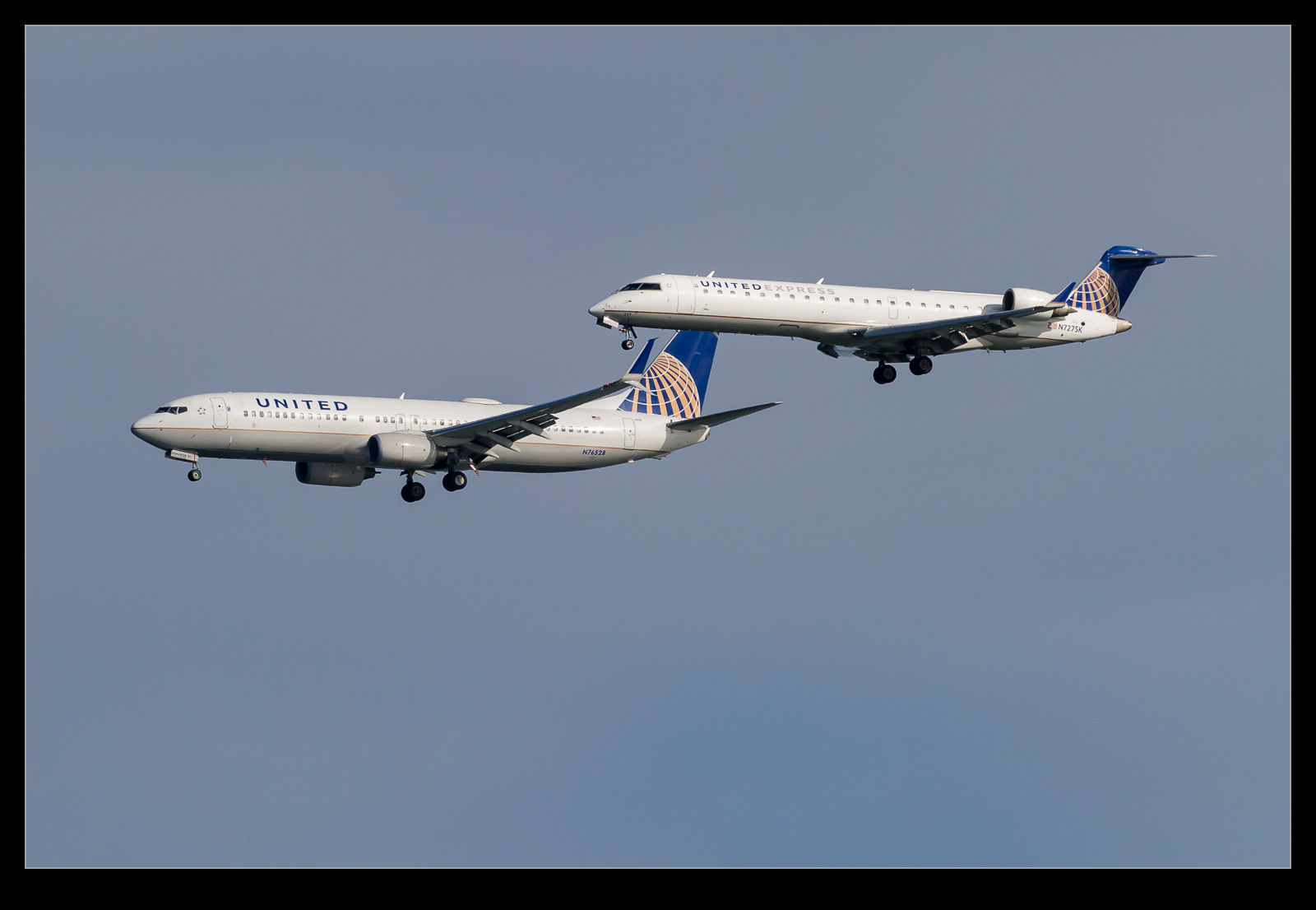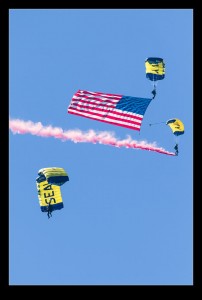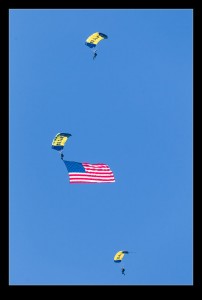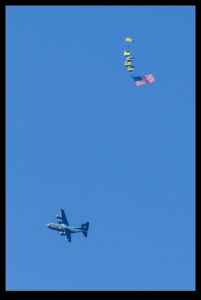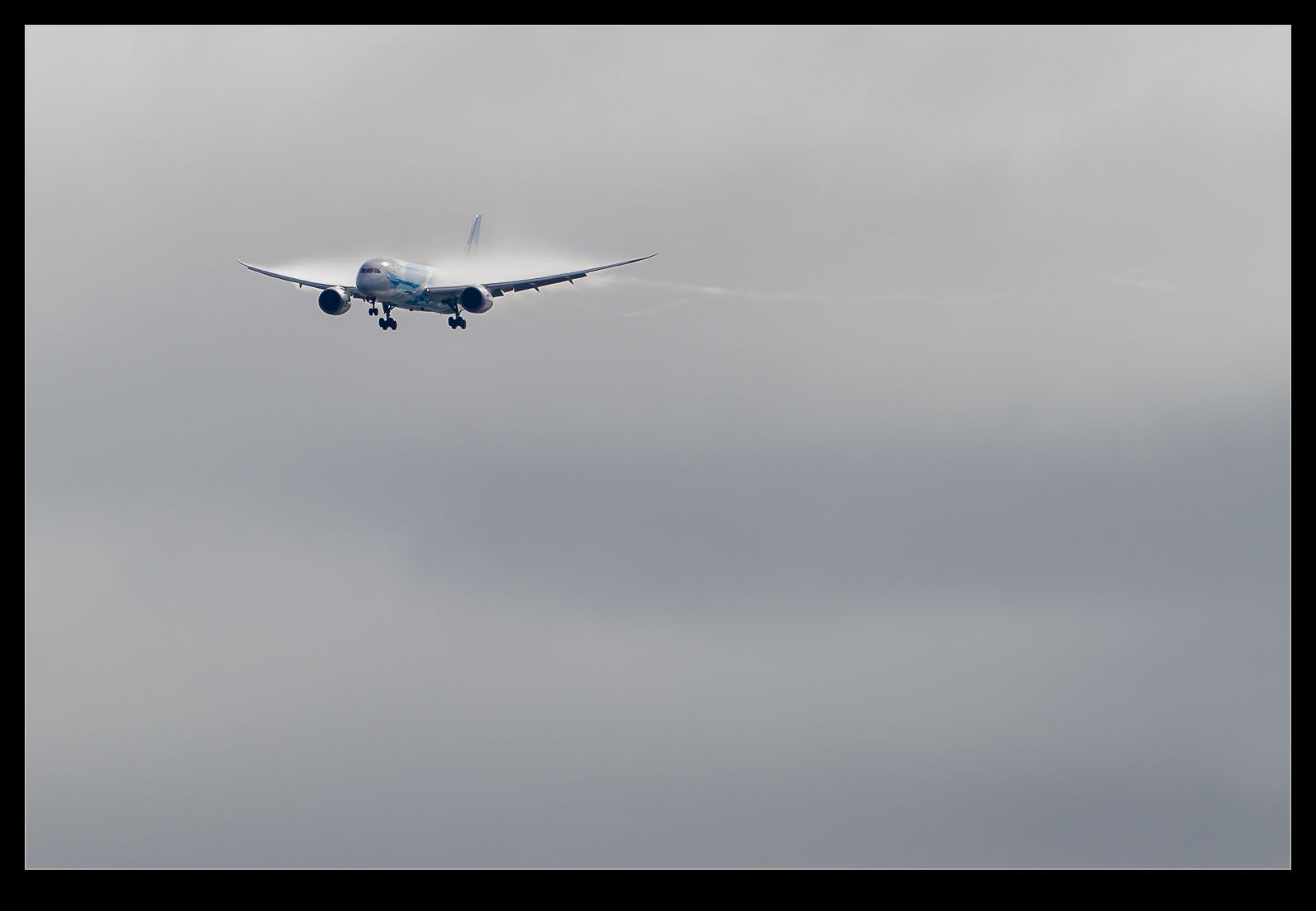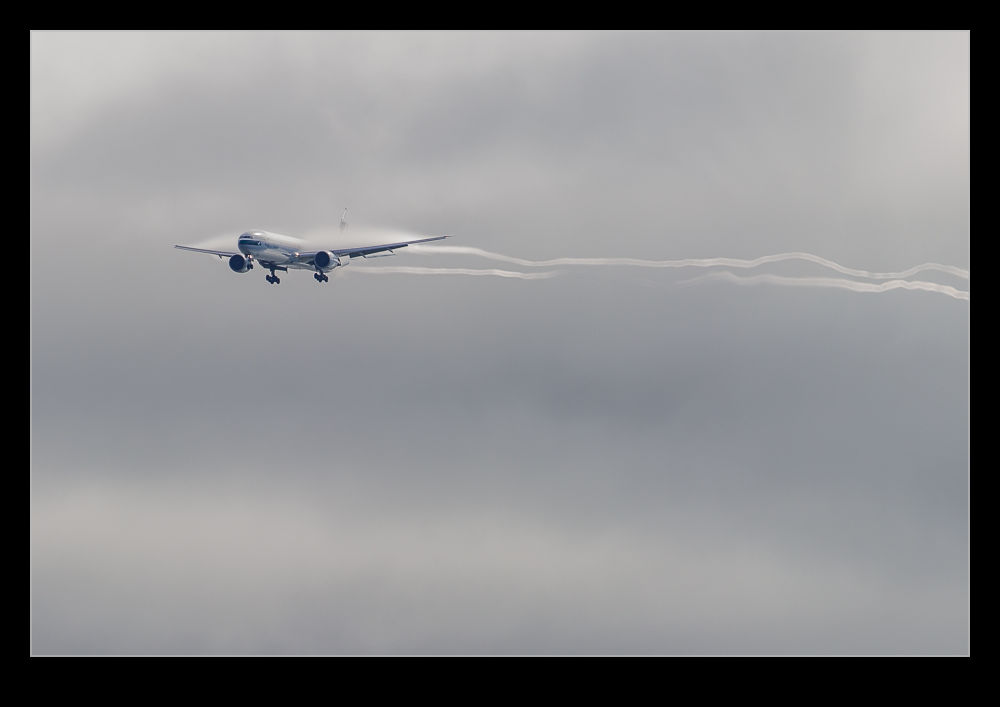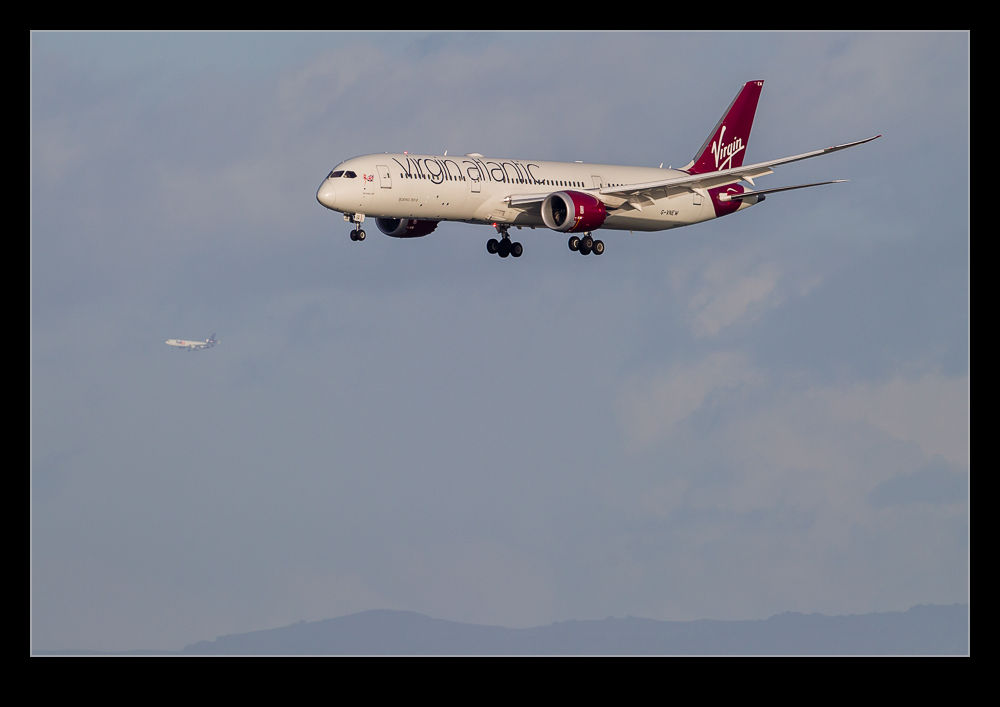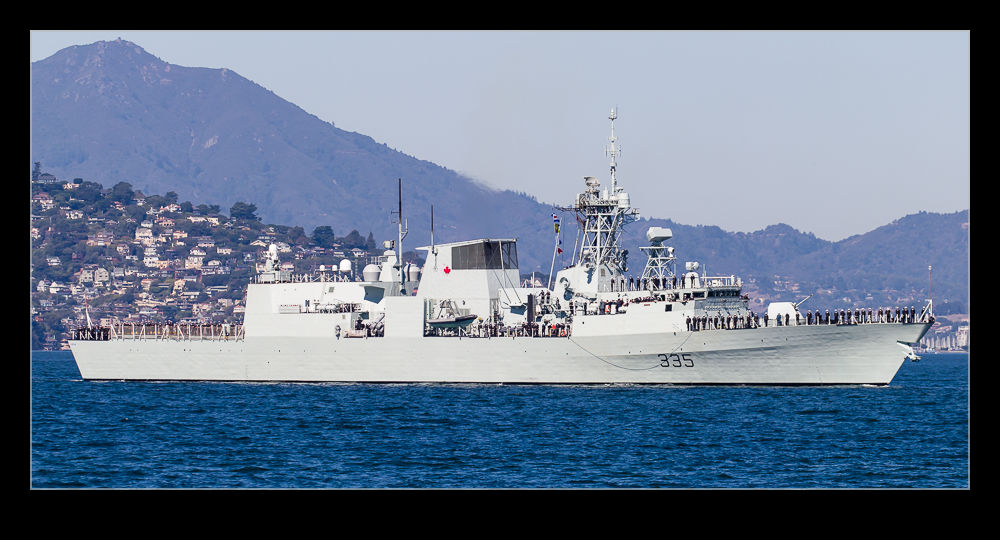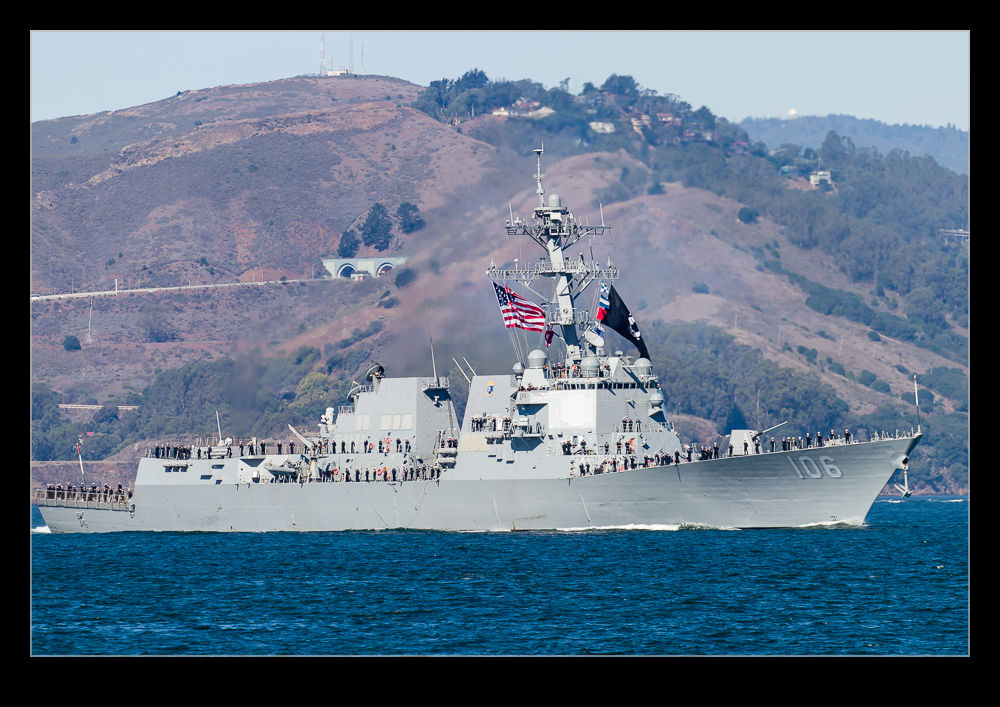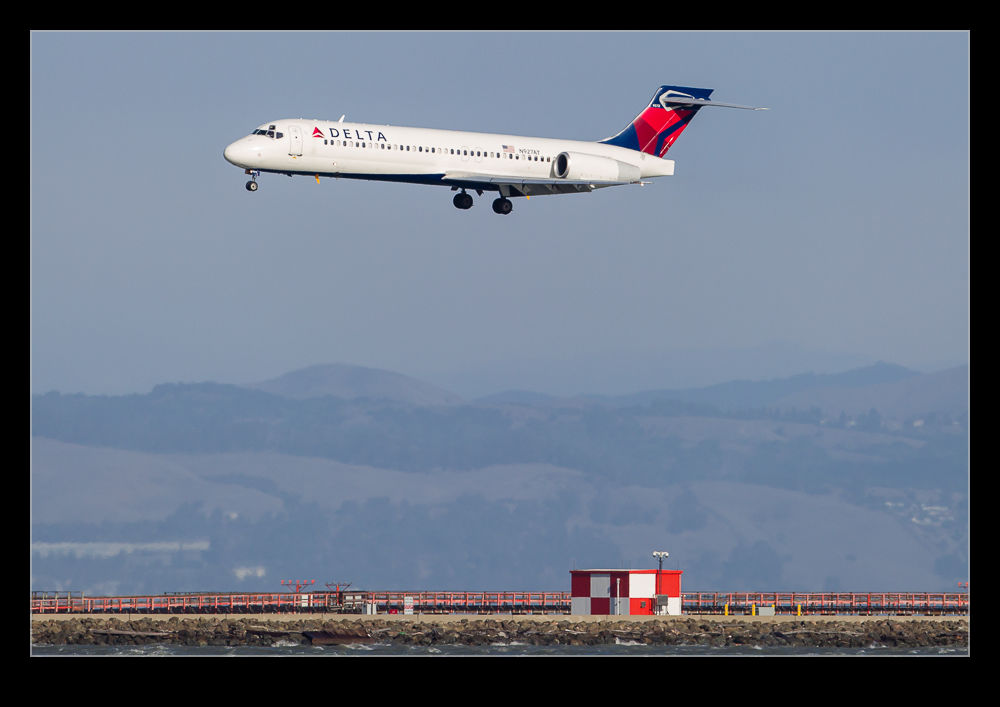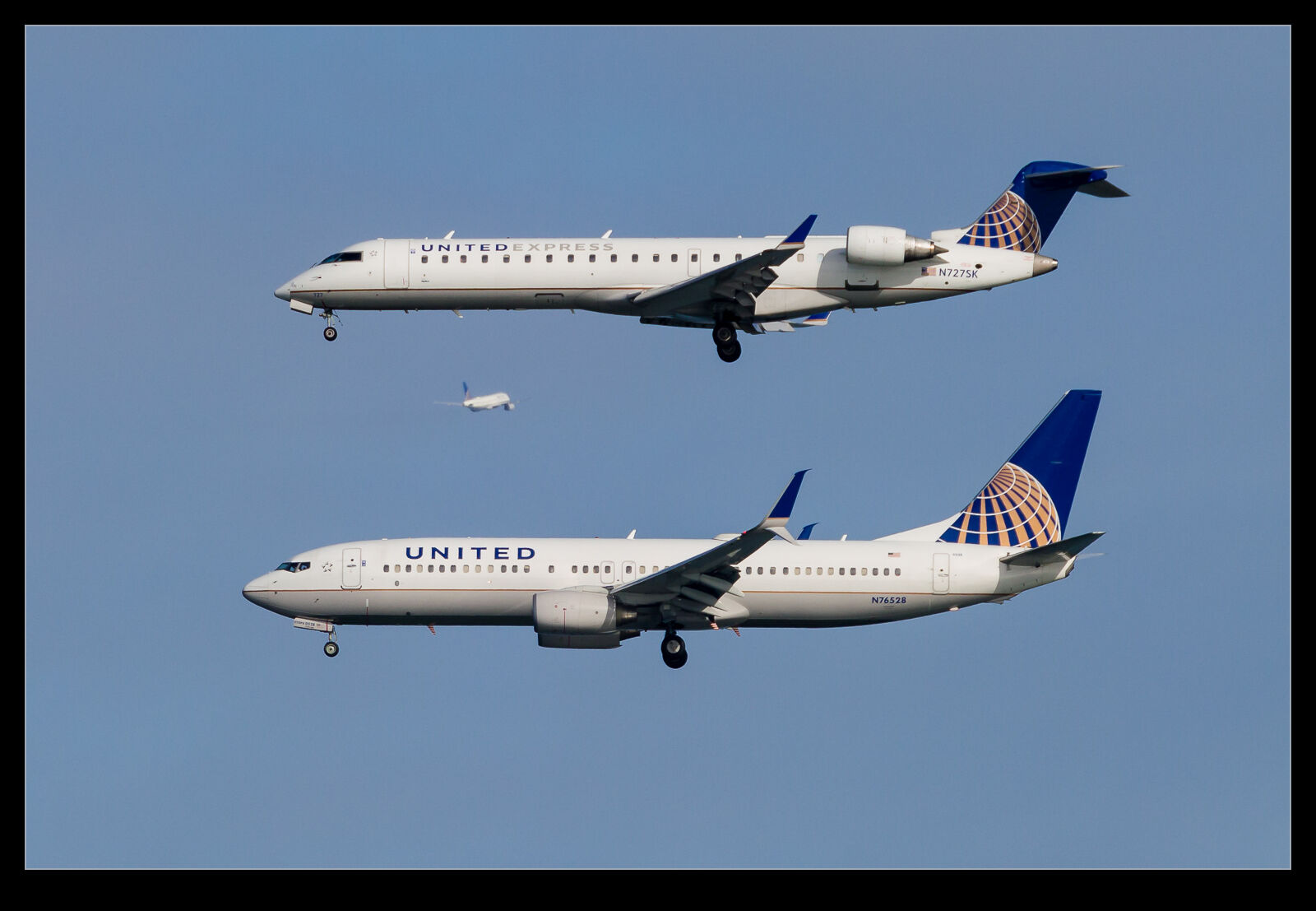 The parallel approaches at SFO are well enough known. I have blogged about them myself here and here. Getting two planes in the same shot is a cool result but it isn’t often that you get three and all of them from the same airline. I was out with Hayman and Roger when a pair of jets came down the approach almost perfectly together. We all got shots of them as they came in. I didn’t notice anything further until I was looking through the shots back at home. Apparently, a United jet was departing prior to the arrival of this pair and it happened to fly out on a path that aligned with my view of the pair. Three jets in one shot!
The parallel approaches at SFO are well enough known. I have blogged about them myself here and here. Getting two planes in the same shot is a cool result but it isn’t often that you get three and all of them from the same airline. I was out with Hayman and Roger when a pair of jets came down the approach almost perfectly together. We all got shots of them as they came in. I didn’t notice anything further until I was looking through the shots back at home. Apparently, a United jet was departing prior to the arrival of this pair and it happened to fly out on a path that aligned with my view of the pair. Three jets in one shot!
Tag Archives: san francisco
Leap Frogs
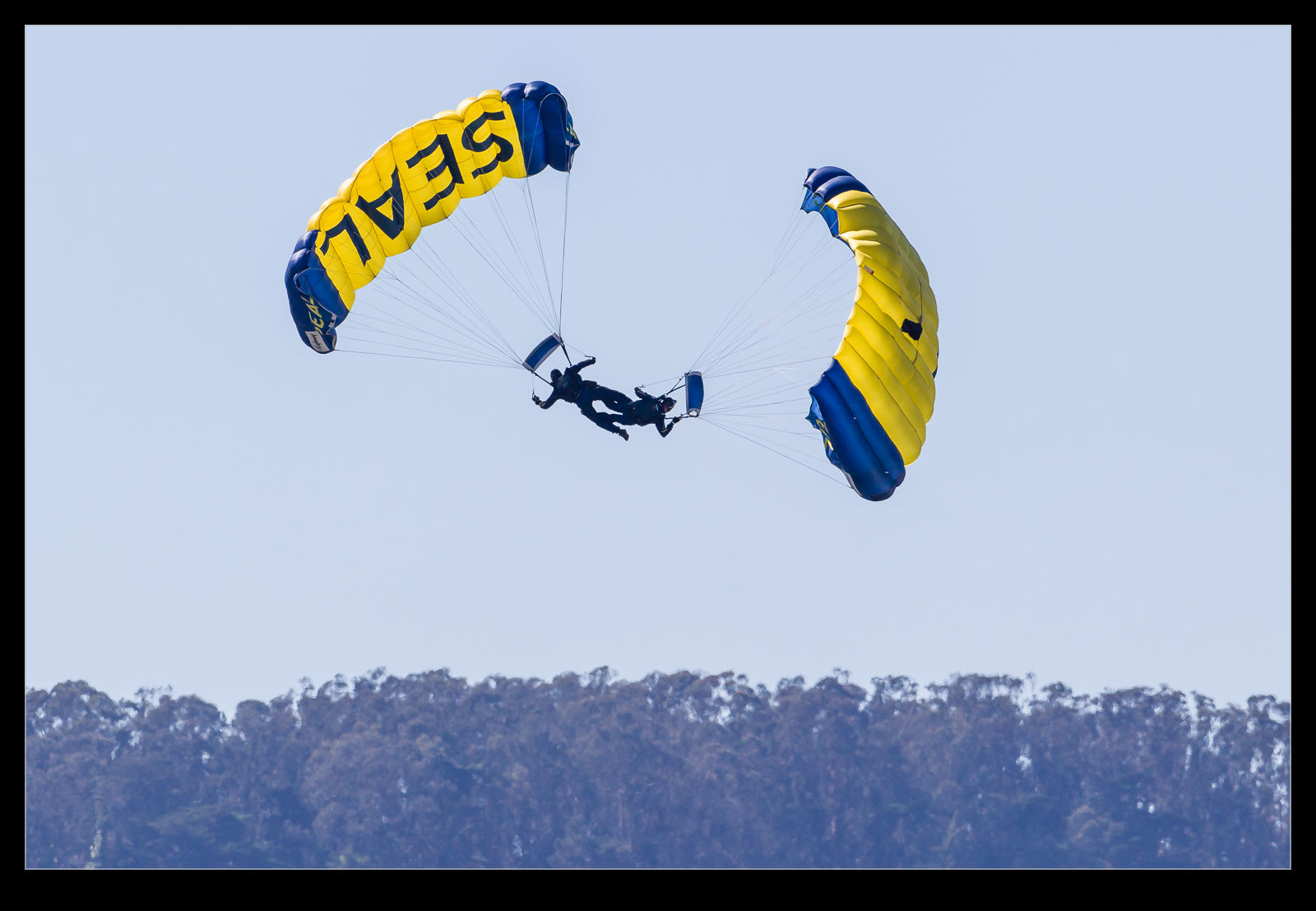 The Leap Frogs are a parachute display team from the Seals. I have seen them a few times at shows in the Midwest – sometimes working with the Golden Knights of the US Army. During Fleet Week the Leap Frogs jumped to open the main part of the air show. On the day I went, they jumped from Fat Albert, the C-130 of the Blue Angels. Apparently, they also used an Air National Guard C-130 over the weekend.
The Leap Frogs are a parachute display team from the Seals. I have seen them a few times at shows in the Midwest – sometimes working with the Golden Knights of the US Army. During Fleet Week the Leap Frogs jumped to open the main part of the air show. On the day I went, they jumped from Fat Albert, the C-130 of the Blue Angels. Apparently, they also used an Air National Guard C-130 over the weekend.
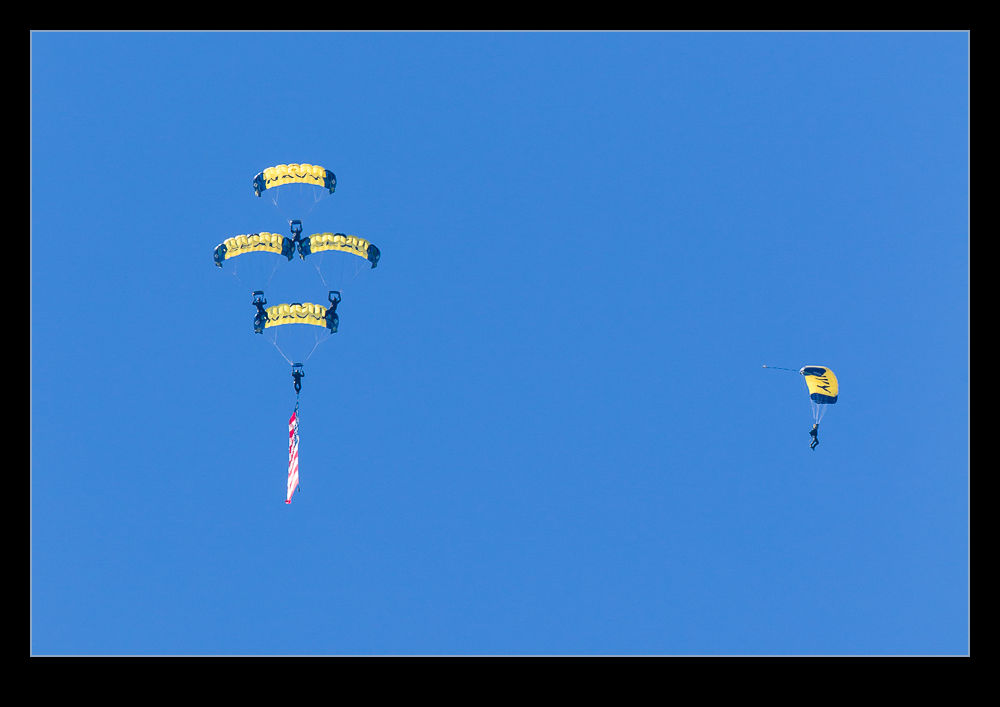 Their jump routine is pretty cool. They do a lot of coordinated work once under canopies. They make a cool four canopy stack which takes a while to form up but, when formed, looks neat. I just wish they would hold it until they were a bit lower. They also do a nice pairs arrangement where two jumpers hook legs and end up plummeting downwards breaking just in time to land. Always a good way to get the crowd on edge!
Their jump routine is pretty cool. They do a lot of coordinated work once under canopies. They make a cool four canopy stack which takes a while to form up but, when formed, looks neat. I just wish they would hold it until they were a bit lower. They also do a nice pairs arrangement where two jumpers hook legs and end up plummeting downwards breaking just in time to land. Always a good way to get the crowd on edge!
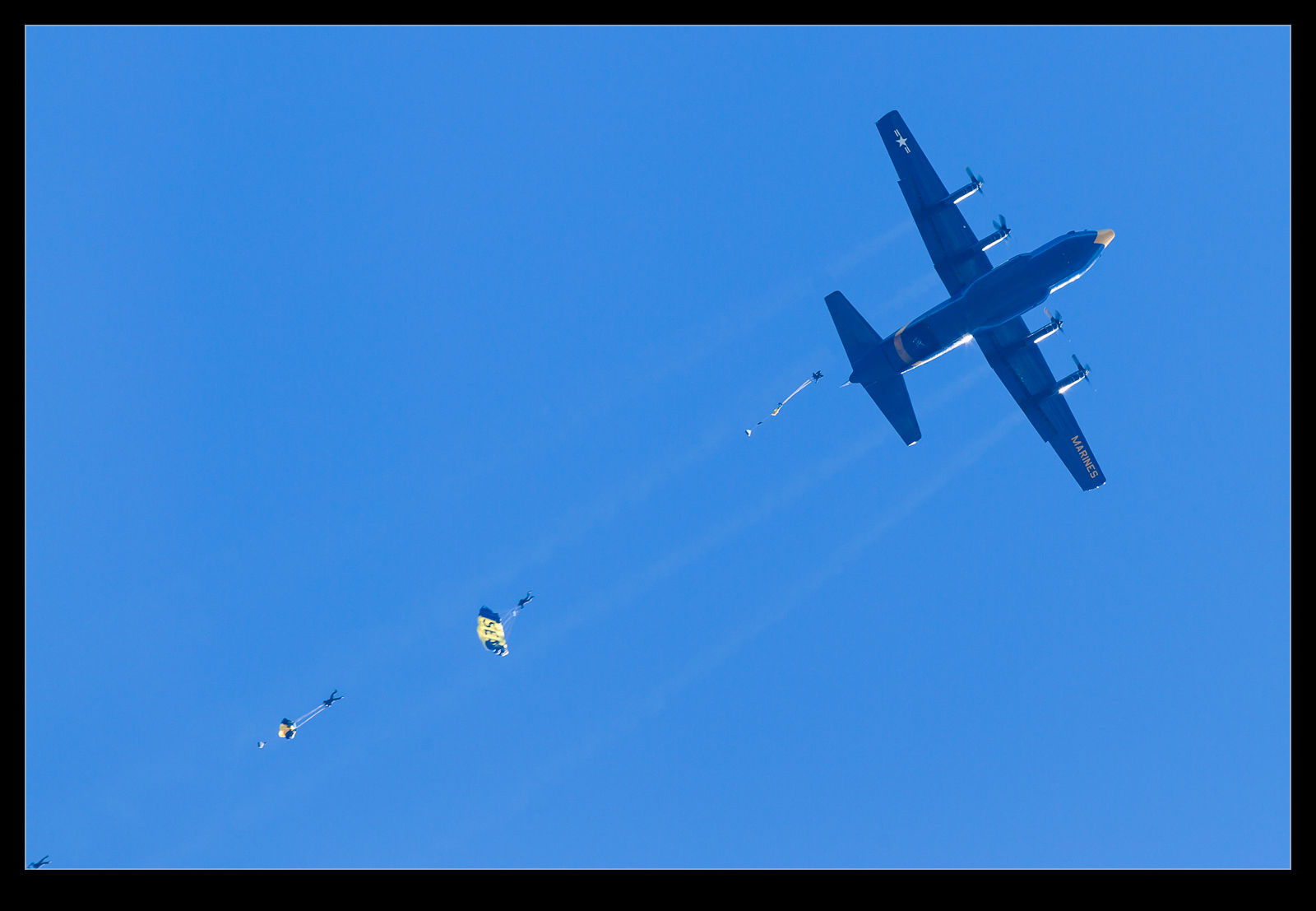 My shots of parachute teams have tended to get a bit samey over time but I still like getting some shots of them as you never know whether you will get a slightly different angle on something or that the lighting will show something special.
My shots of parachute teams have tended to get a bit samey over time but I still like getting some shots of them as you never know whether you will get a slightly different angle on something or that the lighting will show something special.
Humid Approaches to SFO
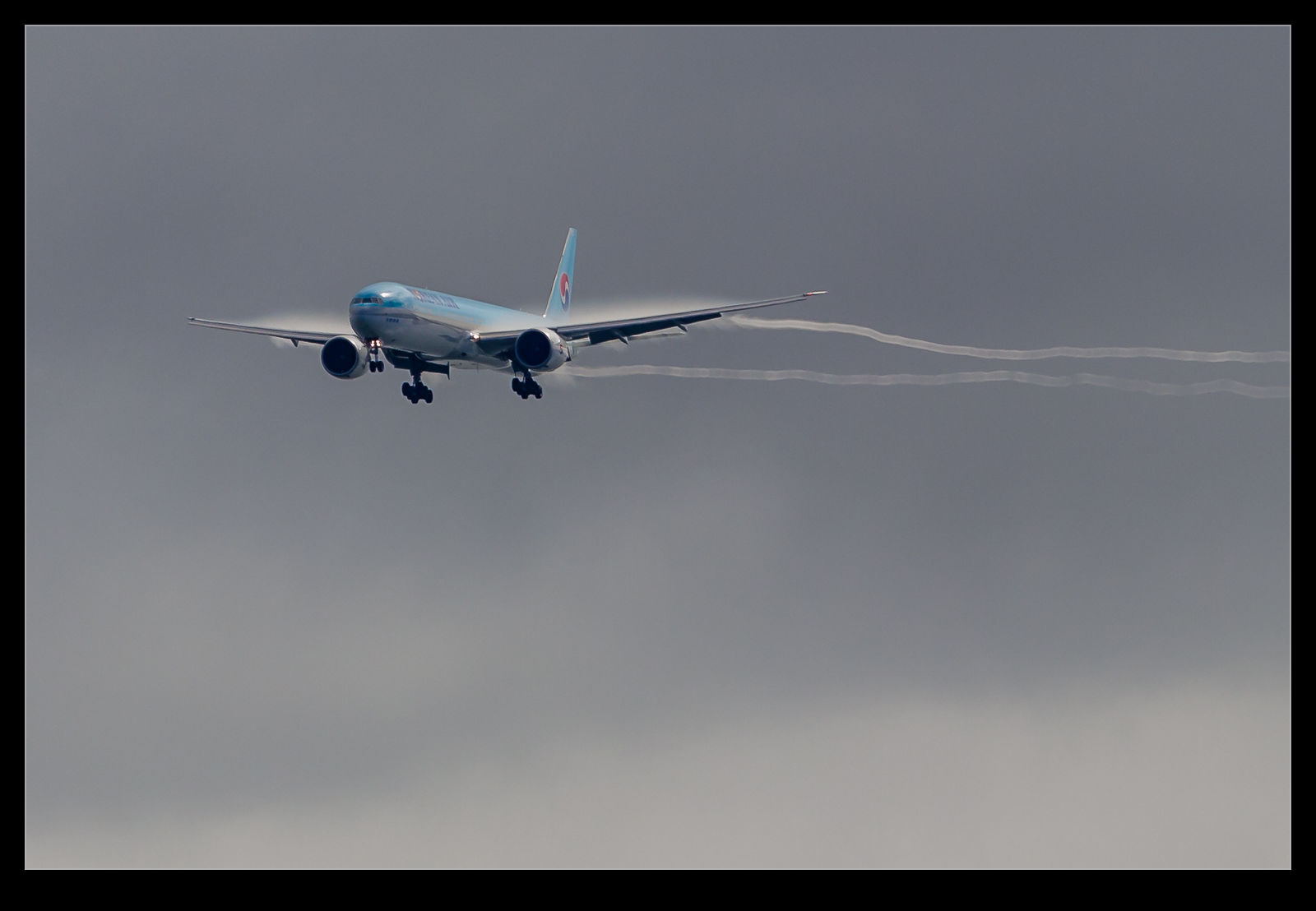 Moisture in the air is not always what you want when you are out shooting aircraft. However, it does have its benefits if there isn’t so much of it that everything is either obscured or gray. The weather conditions over San Francisco Bay can be very localized and, as the planes come down final approach, they can go through quite a variety. I was out hunting for Air Force One a while back and I got some good examples of this.
Moisture in the air is not always what you want when you are out shooting aircraft. However, it does have its benefits if there isn’t so much of it that everything is either obscured or gray. The weather conditions over San Francisco Bay can be very localized and, as the planes come down final approach, they can go through quite a variety. I was out hunting for Air Force One a while back and I got some good examples of this.
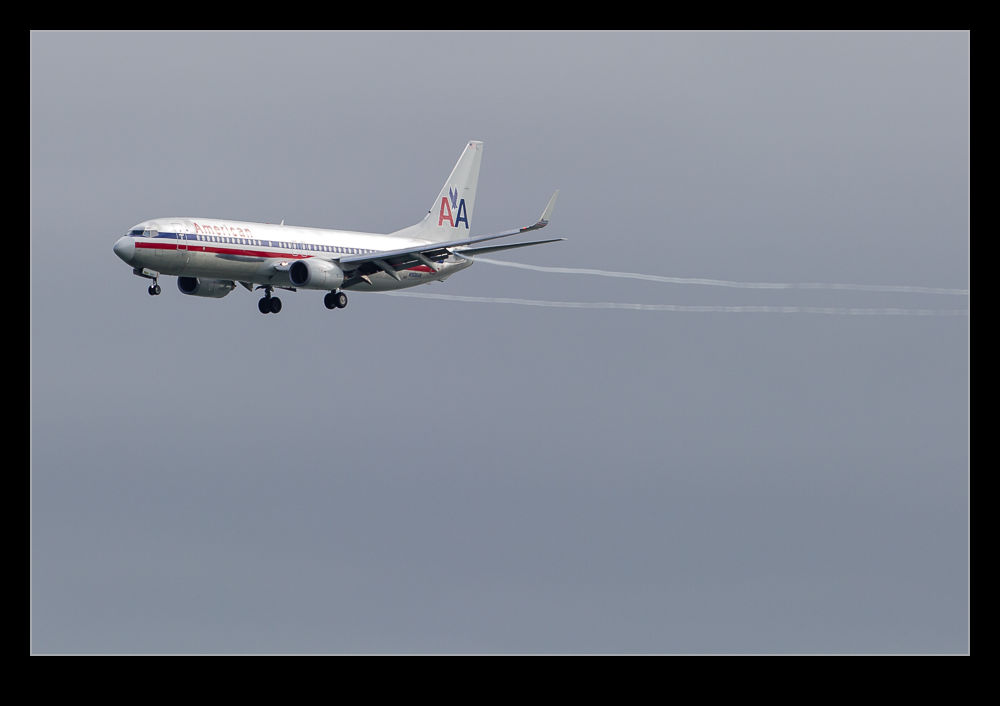 The weather at SFO was actually quite nice (although not when Air Force one departed as I have previously written about). The sun was out and the sky was pretty clear. In fact, there was quite a troubling amount of heat haze. However, once you got towards the south end of the bay, there was pretty solid cloud cover. The planes coming in were in full IMC for a good portion of their approach. Somewhere in the region between Coyote Point and the San Mateo Bridge they would break out of the cloud cover. Then, for the next mile or so, they were in the clear but still in very humid conditions.
The weather at SFO was actually quite nice (although not when Air Force one departed as I have previously written about). The sun was out and the sky was pretty clear. In fact, there was quite a troubling amount of heat haze. However, once you got towards the south end of the bay, there was pretty solid cloud cover. The planes coming in were in full IMC for a good portion of their approach. Somewhere in the region between Coyote Point and the San Mateo Bridge they would break out of the cloud cover. Then, for the next mile or so, they were in the clear but still in very humid conditions.
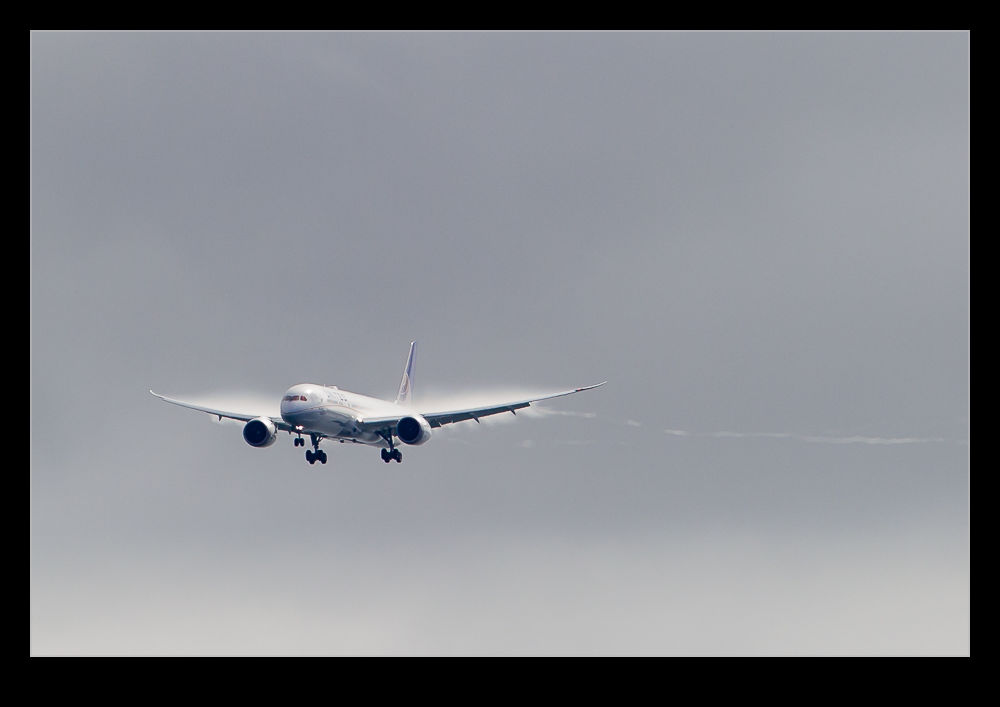 The result of this humidity was a lot of vapor forming up over the wings. The low speed and high lift configuration made the wings a good place to get cloud formations as the moist air passed over them. Additionally, the trailing vortices were showing up well as a result of the condensing moisture in them too. For quite a while, each aircraft showed similar patterns as it descended. The widebodies seemed to be better for showing this but that might just be a function of them being easier to see further away when the effect was most pronounced. The closer they got to the field, the less the effect until it was pretty much gone when they were on final approach.
The result of this humidity was a lot of vapor forming up over the wings. The low speed and high lift configuration made the wings a good place to get cloud formations as the moist air passed over them. Additionally, the trailing vortices were showing up well as a result of the condensing moisture in them too. For quite a while, each aircraft showed similar patterns as it descended. The widebodies seemed to be better for showing this but that might just be a function of them being easier to see further away when the effect was most pronounced. The closer they got to the field, the less the effect until it was pretty much gone when they were on final approach.
Virgin Dreamliner
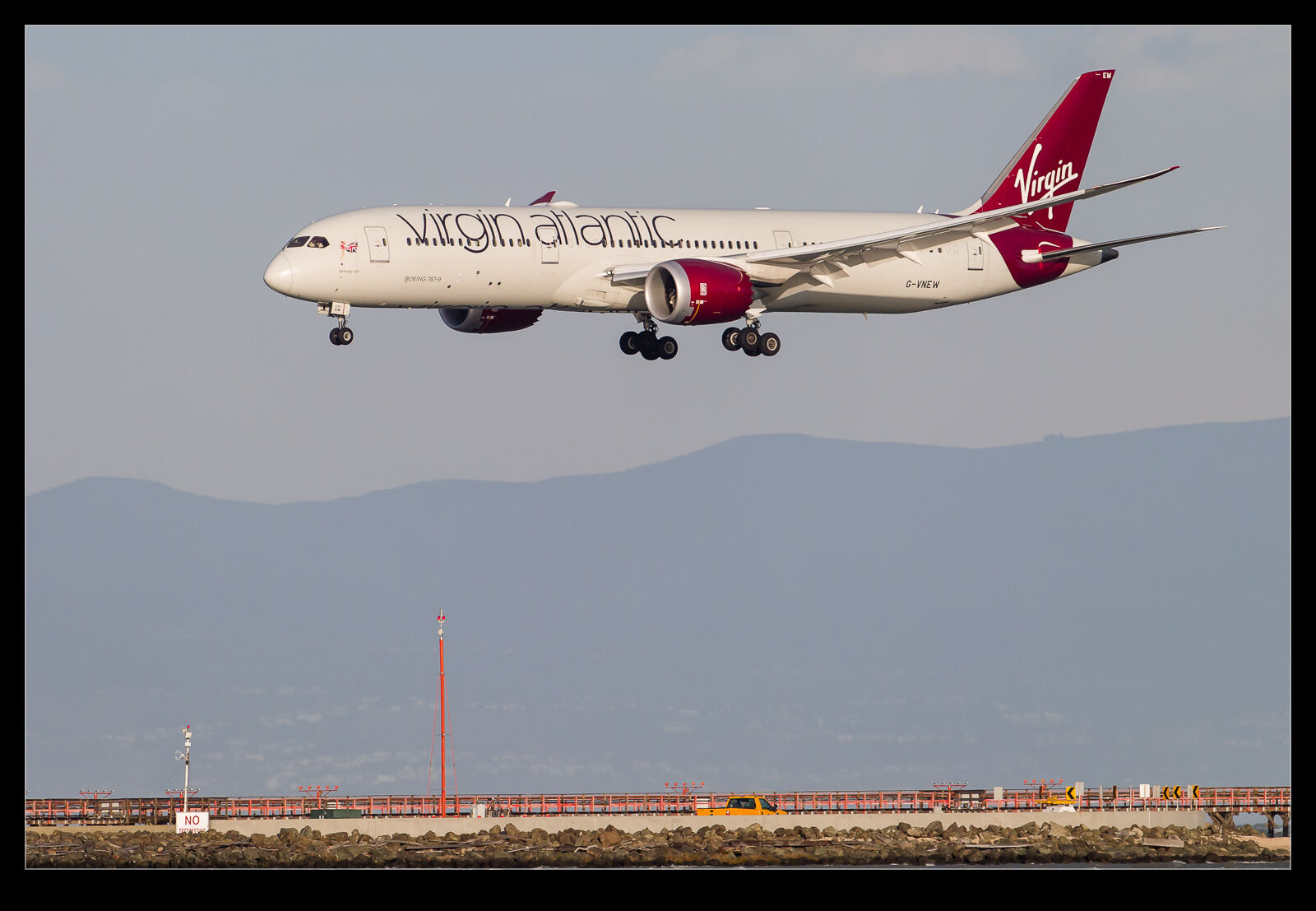 Not long ago I wrote here about the effort to get a Virgin Atlantic A340-600 before they were retired. At the time I noted that Virgin had added a second flight to SFO and it was using the 340 prior to the availability of the Boeing 787-9 later in the year. It turns out that things have changed a little. The 787 is now operating the service but, rather than replace the A340, it has replaced the 747-400 and the A340 is running the additional flight albeit only on weekdays.
Not long ago I wrote here about the effort to get a Virgin Atlantic A340-600 before they were retired. At the time I noted that Virgin had added a second flight to SFO and it was using the 340 prior to the availability of the Boeing 787-9 later in the year. It turns out that things have changed a little. The 787 is now operating the service but, rather than replace the A340, it has replaced the 747-400 and the A340 is running the additional flight albeit only on weekdays.
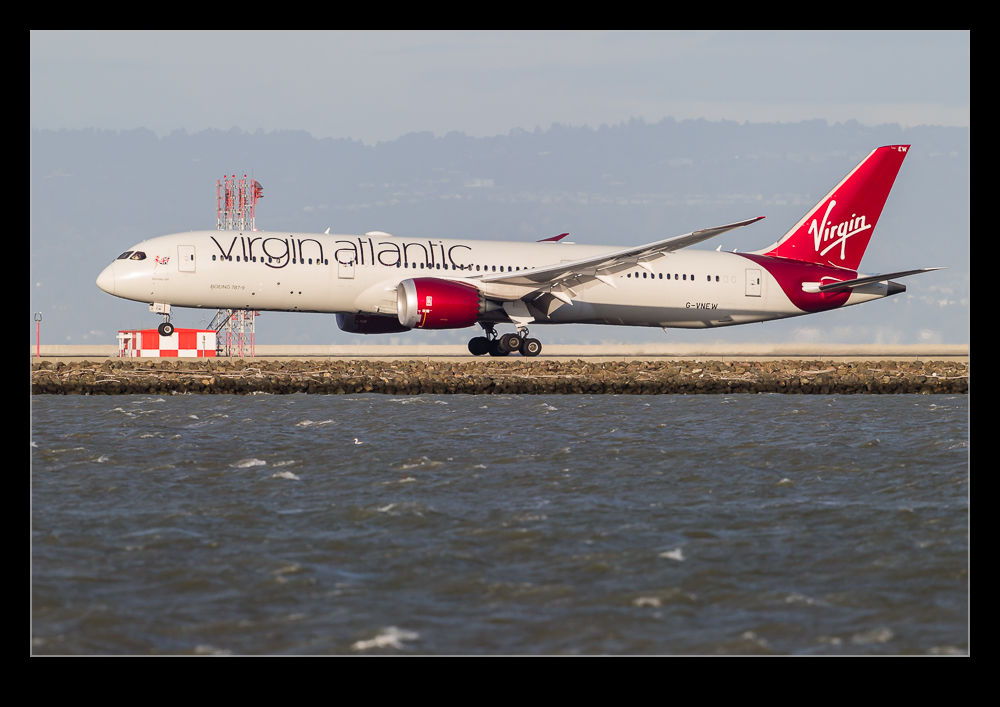 The loss of the 747 is another example of how quickly they are disappearing from services as I have written about a few times now. However, it is nice to have the new type and still retain the increasingly rare A340. Unfortunately, getting out on a weekday to catch the 340 is not usually practical. I have managed to see the 787 at last though. Winter can be a great time to photograph aircraft with low, soft light. It can also combine with crappy weather in the form of high and gusting winds though. Such was the case this time. Hiding behind a tree to try and minimize the impact on the camera does help though. Interestingly, the colors of Virgin Atlantic’s latest scheme do not seem to like digital capture. The red seems a lot more subdued in my images than I recall it being!
The loss of the 747 is another example of how quickly they are disappearing from services as I have written about a few times now. However, it is nice to have the new type and still retain the increasingly rare A340. Unfortunately, getting out on a weekday to catch the 340 is not usually practical. I have managed to see the 787 at last though. Winter can be a great time to photograph aircraft with low, soft light. It can also combine with crappy weather in the form of high and gusting winds though. Such was the case this time. Hiding behind a tree to try and minimize the impact on the camera does help though. Interestingly, the colors of Virgin Atlantic’s latest scheme do not seem to like digital capture. The red seems a lot more subdued in my images than I recall it being!
Nippon Cargo 747-8
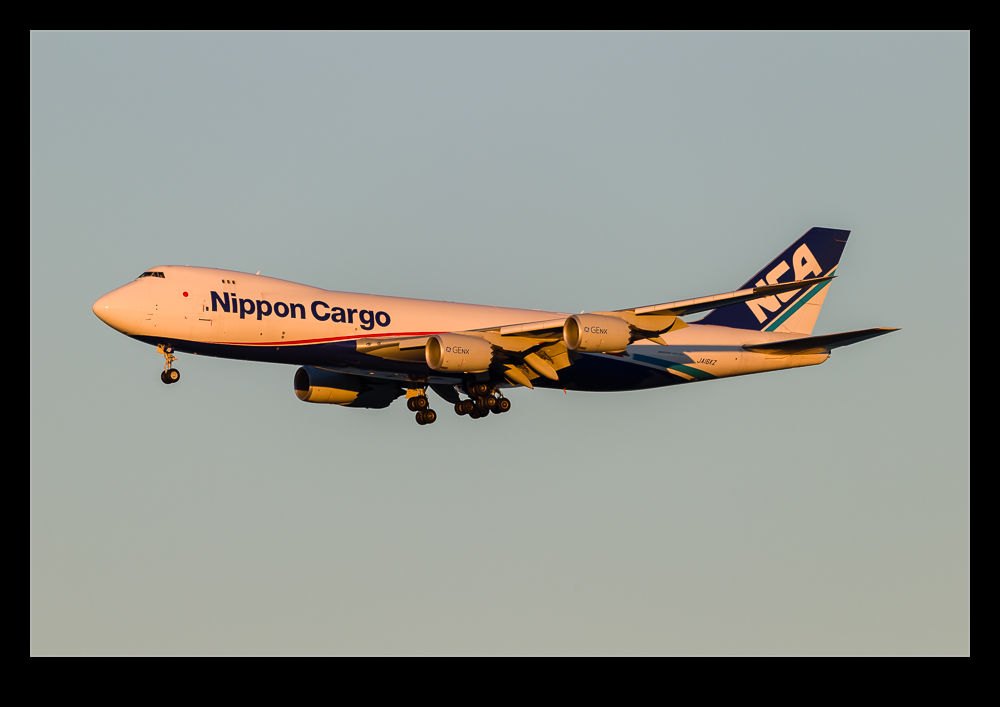 Today’s pictures involve a shout out to Roger Cain who was the one that let me know that this movement was happening. Nippon Cargo operates a regular service to SFO with their Boeing 747-8 freighter. Normally it arrives early in the morning and departs not long afterwards when the light is just coming up. This does not make for a good opportunity to get a good shot of it. For some reason, it was running late and was showing as due in to SFO shortly before sunset.
Today’s pictures involve a shout out to Roger Cain who was the one that let me know that this movement was happening. Nippon Cargo operates a regular service to SFO with their Boeing 747-8 freighter. Normally it arrives early in the morning and departs not long afterwards when the light is just coming up. This does not make for a good opportunity to get a good shot of it. For some reason, it was running late and was showing as due in to SFO shortly before sunset.
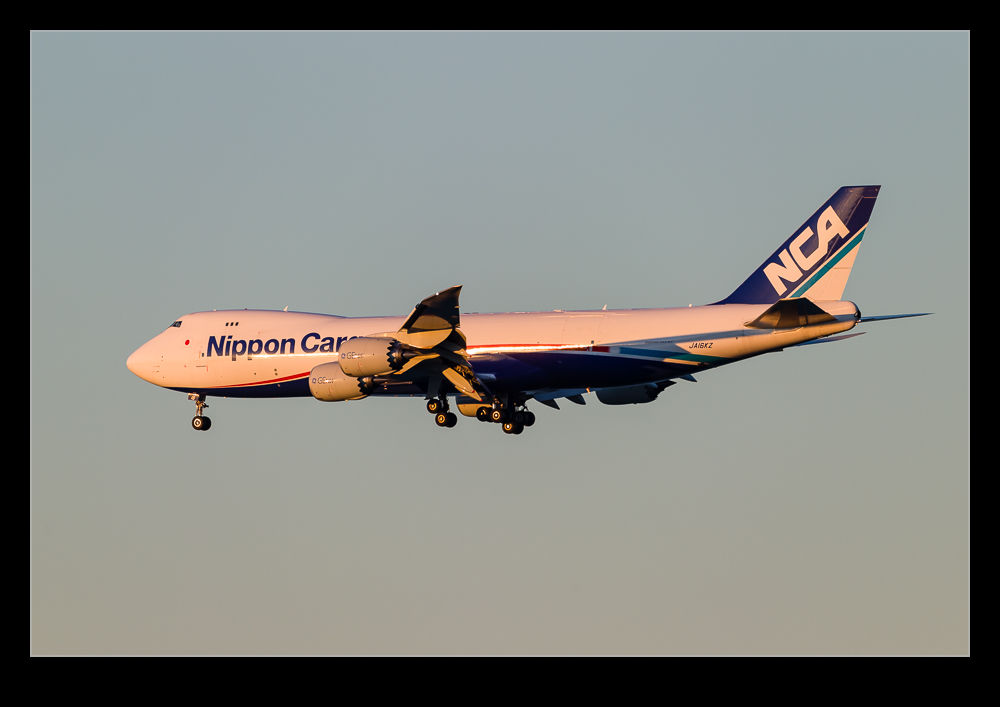 I was in the East Bay dealing with the replacement of a tire on my car. Roger called to tell me about it. What I didn’t know was a) whether I would be able to get across in time based on the tire being fixed and b) whether it would actually depart LAX, its previous stop, soon enough to arrive at SFO before it got dark. Driving across the bay to miss the light was not something I wanted to do. Both Roger and I were tracking the jet online and, as I got the car back, he called to say it was taxiing for departure at LAX.
I was in the East Bay dealing with the replacement of a tire on my car. Roger called to tell me about it. What I didn’t know was a) whether I would be able to get across in time based on the tire being fixed and b) whether it would actually depart LAX, its previous stop, soon enough to arrive at SFO before it got dark. Driving across the bay to miss the light was not something I wanted to do. Both Roger and I were tracking the jet online and, as I got the car back, he called to say it was taxiing for departure at LAX.
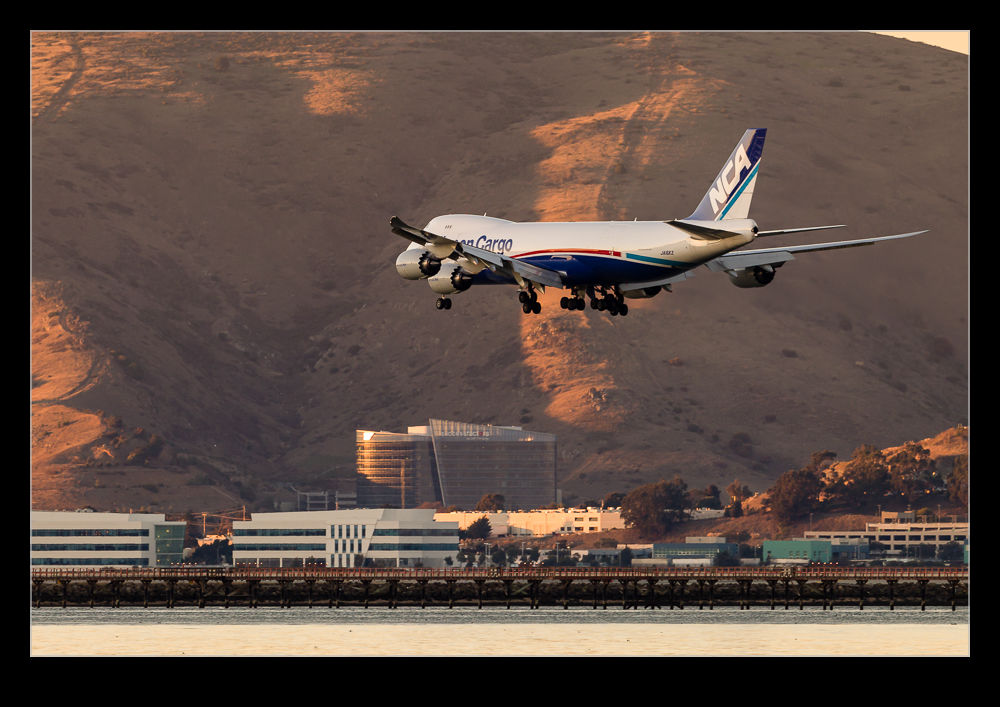 I headed across the bay and got to Roger about ten minutes before it was due to arrive. The light was beginning to go down but it looked like it would work out okay. Sure enough, it came into view just before the sun went below the hills. We got some really nice light on it. I continued to track it to touchdown but, by the time it got to the runway, it was already in shade. It was that close!
I headed across the bay and got to Roger about ten minutes before it was due to arrive. The light was beginning to go down but it looked like it would work out okay. Sure enough, it came into view just before the sun went below the hills. We got some really nice light on it. I continued to track it to touchdown but, by the time it got to the runway, it was already in shade. It was that close!
Zoomify the SFO Departures
I was recently drawn back to something I had experimented with a long time ago but had since forgotten about. I was at SFO when the wind was strong enough to require all departures to operate from the 28s. This resulted in a long line of jets along the taxiway beside the runways as they waited their turn to take off. I shot a very wide panorama shot of them all lined up. It didn’t help that they weren’t bunched too tightly but, even if they had been, the pano that results is very wide and shallow.
There is nothing much you can do with this unless you have a long wall waiting for a mural (which I don’t). However, I still liked the shot. What to do with it? Then I remembered Zoomify. This is an output format embedded within Photoshop that creates a web page that you can zoom in and out of and pan around. It allows someone to explore a large image in more detail if they want to do so. Not quite on the scale of Gigapan images but still a neat tool when you need something slightly different.
Parade of Ships
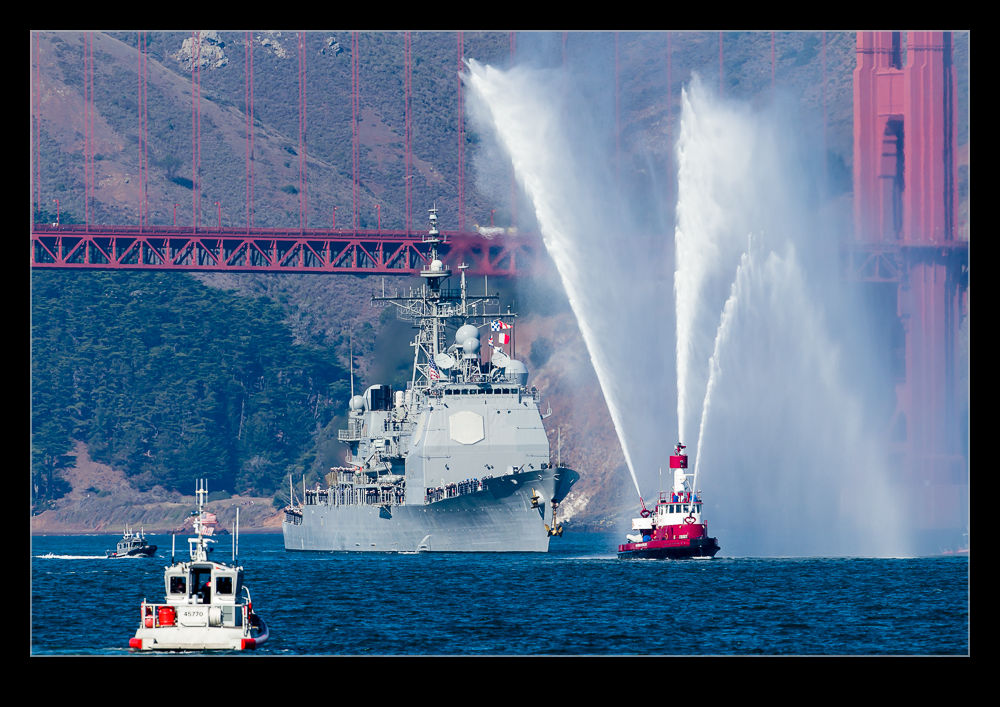 I have mentioned the LCS ship that was part of the Parade of Ships for Fleet Week. It was one of several warships to take part in the parade. Most were US Navy ships but there was also a Coast Guard ship and a visitor from the Royal Canadian Navy. They entered the bay under the Golden Gate Bridge before parading in front of the spectators arrayed along the shore and in the boats out on the water. The first ship was led by a fire boat that sprayed water from its cannons in greeting.
I have mentioned the LCS ship that was part of the Parade of Ships for Fleet Week. It was one of several warships to take part in the parade. Most were US Navy ships but there was also a Coast Guard ship and a visitor from the Royal Canadian Navy. They entered the bay under the Golden Gate Bridge before parading in front of the spectators arrayed along the shore and in the boats out on the water. The first ship was led by a fire boat that sprayed water from its cannons in greeting.
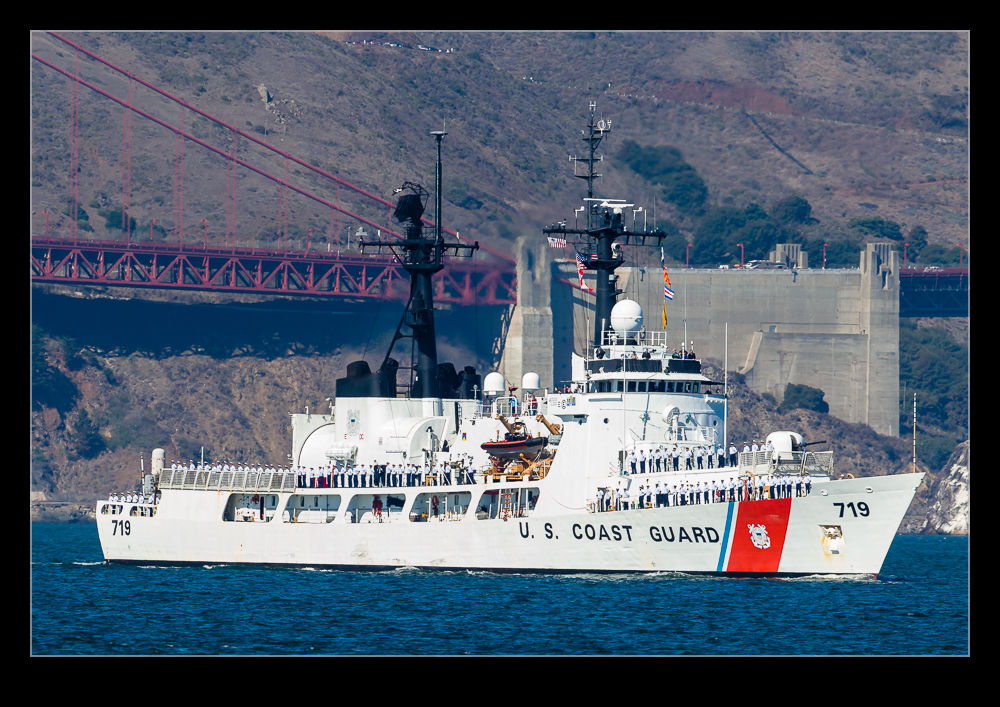 These pictures are a sample of the different ships that were on parade. Another warship was part of Fleet Week but it remained tied up during the parade which was a shame as I would liked to have seen it. You could tour it if you wanted but I had other plans that meant that wouldn’t work out.
These pictures are a sample of the different ships that were on parade. Another warship was part of Fleet Week but it remained tied up during the parade which was a shame as I would liked to have seen it. You could tour it if you wanted but I had other plans that meant that wouldn’t work out.
Delta 717s
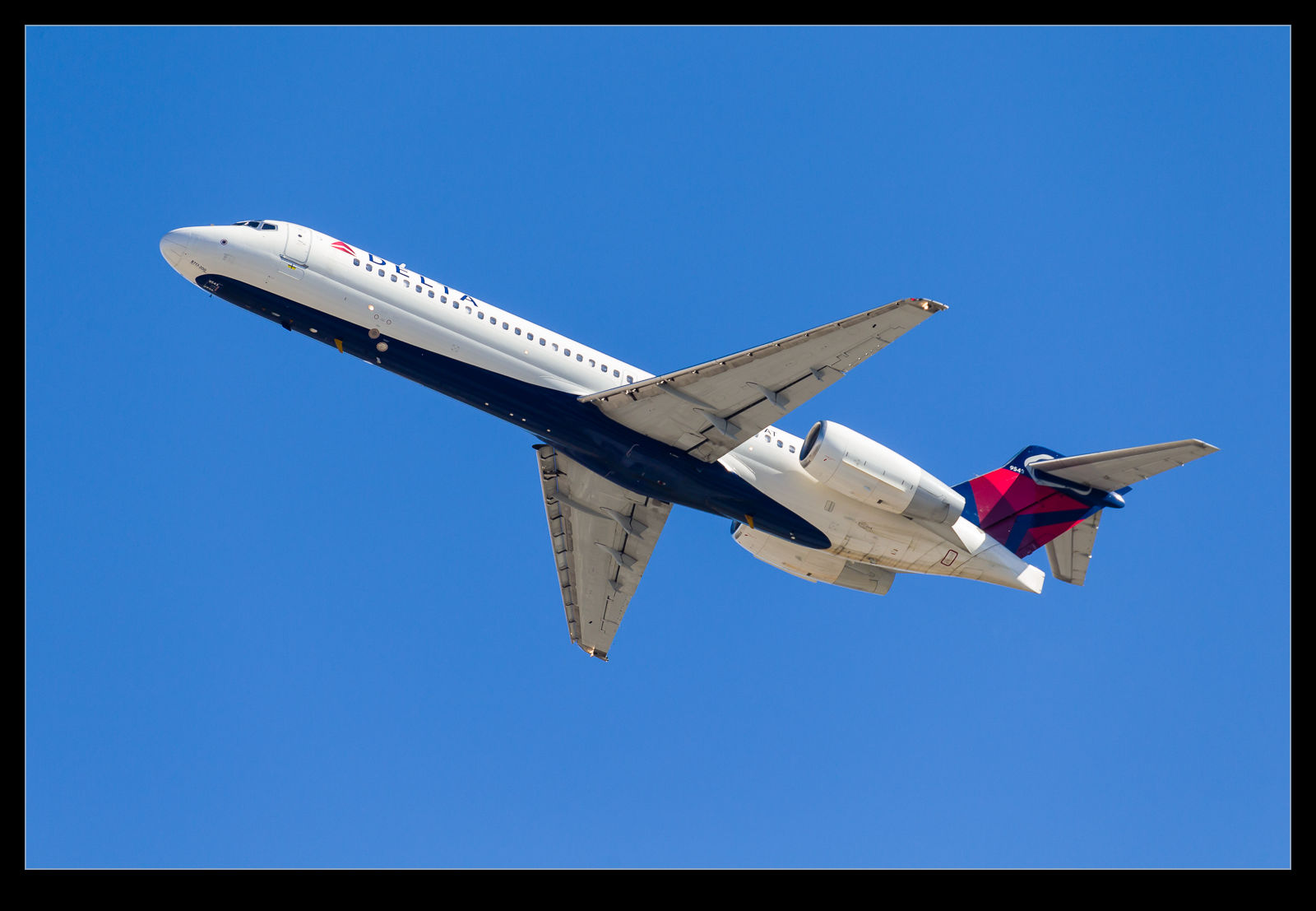 When Southwest bought AirTran, they inherited a mixed fleet of 737s and 717s. AirTran had been a 717 only fleet for a while but had expanded to include 737s as they grew and the production of the 717 ended. It didn’t take too long for Southwest to announce that the 717s were going away. Where to was the question. That was soon answered when Delta picked them all up. Consequently, there has been a steady stream of 717s showing up in Delta colors recently.
When Southwest bought AirTran, they inherited a mixed fleet of 737s and 717s. AirTran had been a 717 only fleet for a while but had expanded to include 737s as they grew and the production of the 717 ended. It didn’t take too long for Southwest to announce that the 717s were going away. Where to was the question. That was soon answered when Delta picked them all up. Consequently, there has been a steady stream of 717s showing up in Delta colors recently.
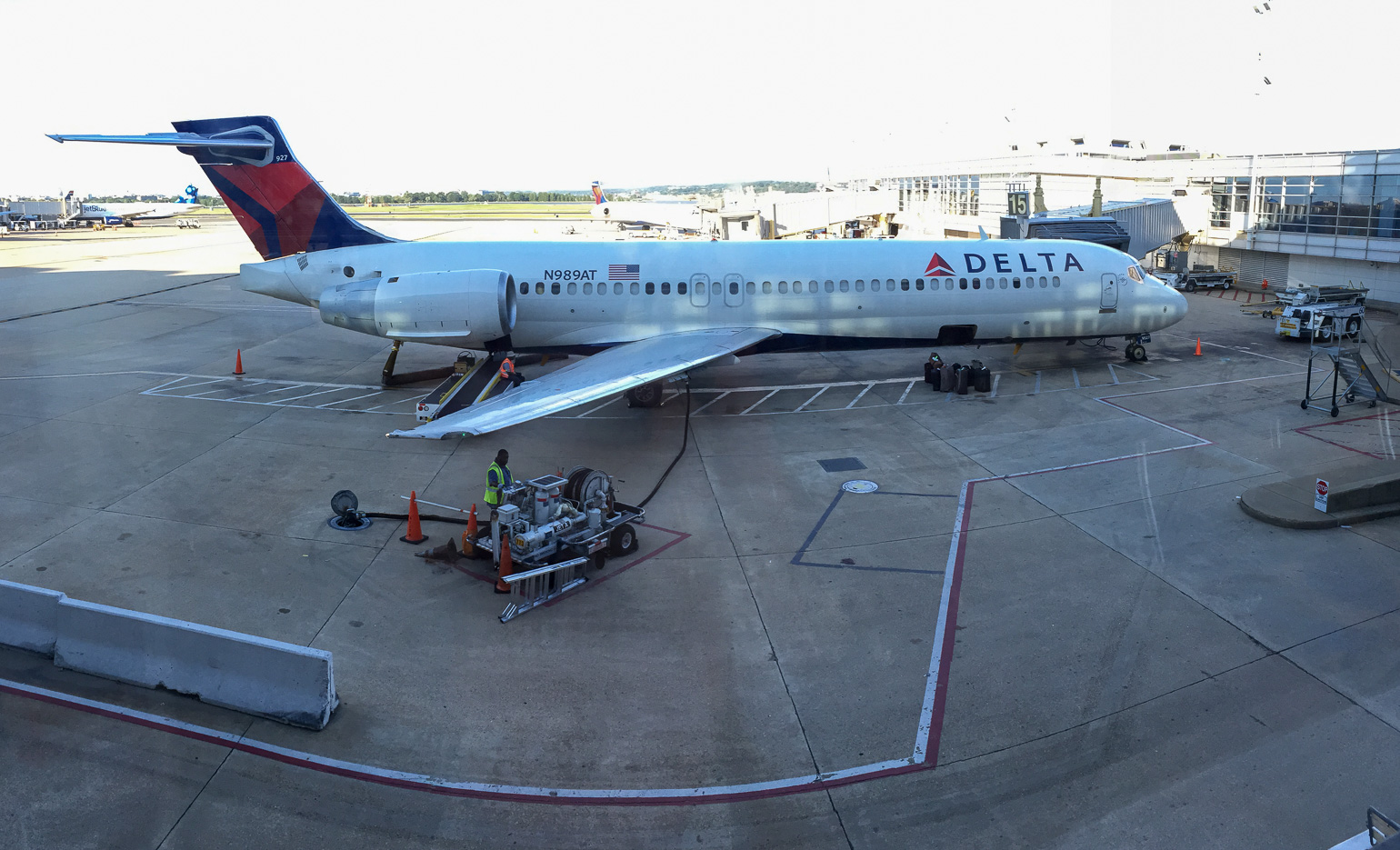 I have come across a few of them recently on both sides of the country. Despite the age of the basic DC-9 design, the updates introduced and the chunkier profile of the more modern engines means that there is something slightly different about the appearance of the jet. I quite like the look of it. Previously, the majority of the examples I had seen had been Hawaiian (including those I had ridden on). It is nice that the type has found a new home which means they shall be around in the US for a while to come.
I have come across a few of them recently on both sides of the country. Despite the age of the basic DC-9 design, the updates introduced and the chunkier profile of the more modern engines means that there is something slightly different about the appearance of the jet. I quite like the look of it. Previously, the majority of the examples I had seen had been Hawaiian (including those I had ridden on). It is nice that the type has found a new home which means they shall be around in the US for a while to come.
Closest Yet on the 777-300ER Gear
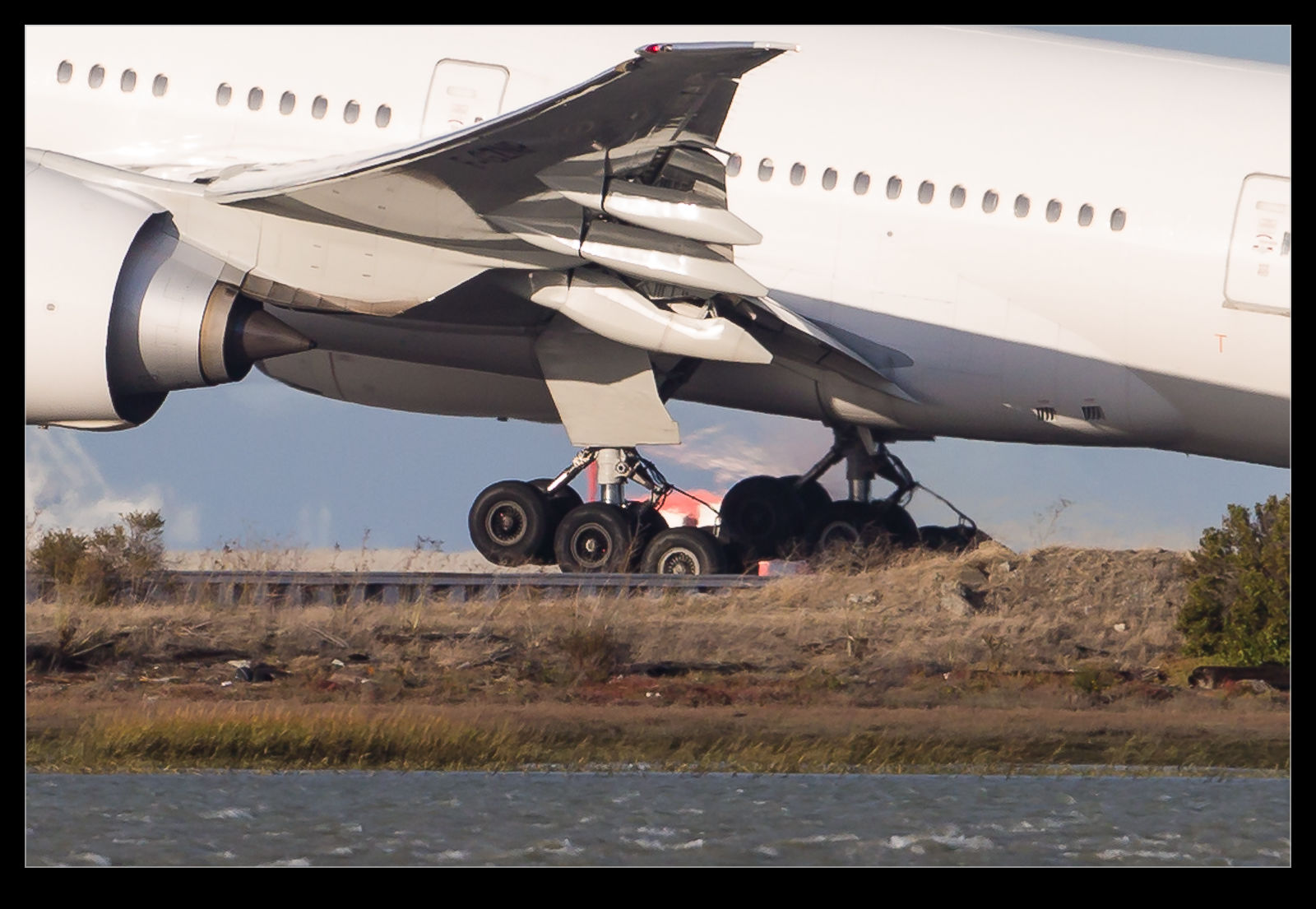 You might not think a really windy day was going to be a great time to head out and take photos with a long lens hand held. This certainly is not ideal but there are some advantages that a really windy day can bring. The purpose of the trip was to catch the new Virgin 787-9 service coming in to SFO on a Sunday afternoon when I didn’t have anything else planned. While the wind was very strong, the light was nice so I gave it a go. What I didn’t realize was that, while it was windy at home, it was really windy at SFO! Everything was operating on the 28s because the wind was above 30kts and gusting to well over 40kts. This also meant that departures got airborne quite quickly given that they started with over 30kts after zero takeoff roll!
You might not think a really windy day was going to be a great time to head out and take photos with a long lens hand held. This certainly is not ideal but there are some advantages that a really windy day can bring. The purpose of the trip was to catch the new Virgin 787-9 service coming in to SFO on a Sunday afternoon when I didn’t have anything else planned. While the wind was very strong, the light was nice so I gave it a go. What I didn’t realize was that, while it was windy at home, it was really windy at SFO! Everything was operating on the 28s because the wind was above 30kts and gusting to well over 40kts. This also meant that departures got airborne quite quickly given that they started with over 30kts after zero takeoff roll!
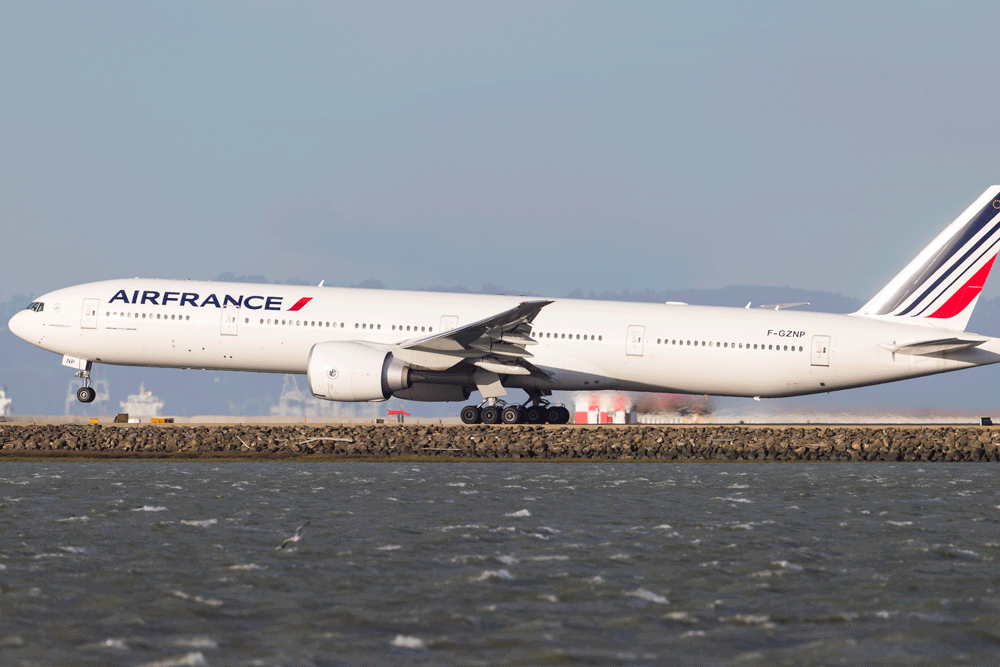 The heavy jets were frequently airborne before the intersection of the runways and this included an Air France 777-300ER. Consequently, I was able to get a clearer view of the gear during rotation than I have managed before. Above are a still of the gear during rotation and also an animated GIF of the rotation in progress. I think I shall consider myself happy with this. It is the best I have got. Unless I get to spend some time out by the runway while one is departing, I doubt I will get a better chance than this.
The heavy jets were frequently airborne before the intersection of the runways and this included an Air France 777-300ER. Consequently, I was able to get a clearer view of the gear during rotation than I have managed before. Above are a still of the gear during rotation and also an animated GIF of the rotation in progress. I think I shall consider myself happy with this. It is the best I have got. Unless I get to spend some time out by the runway while one is departing, I doubt I will get a better chance than this.
USS Coronado LCS
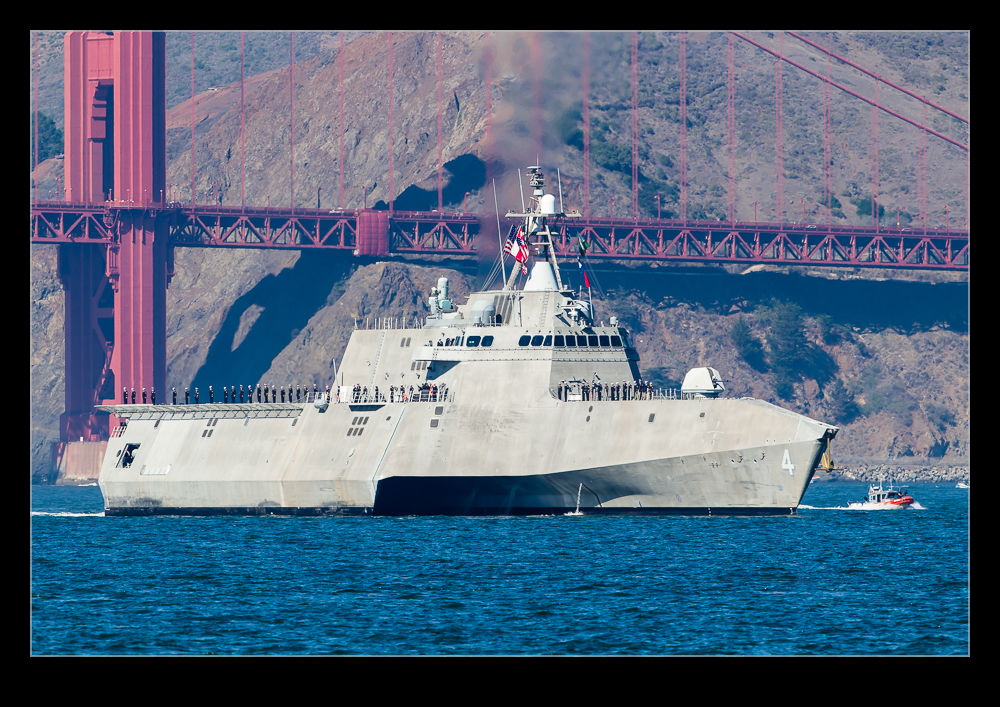 As a small boy, my Gran would take me to Portsmouth each August for Navy Day. We would spend a day walking around the dockyard and getting on to various warships to see what they were like. This was a pretty big event and, in those days, the number of ships in port for those days is probably more than the Royal Navy has in total today. The result of this was an interest in an early day with warships. Growing up by the water meant that ships of all types were a regular feature of life.
As a small boy, my Gran would take me to Portsmouth each August for Navy Day. We would spend a day walking around the dockyard and getting on to various warships to see what they were like. This was a pretty big event and, in those days, the number of ships in port for those days is probably more than the Royal Navy has in total today. The result of this was an interest in an early day with warships. Growing up by the water meant that ships of all types were a regular feature of life.
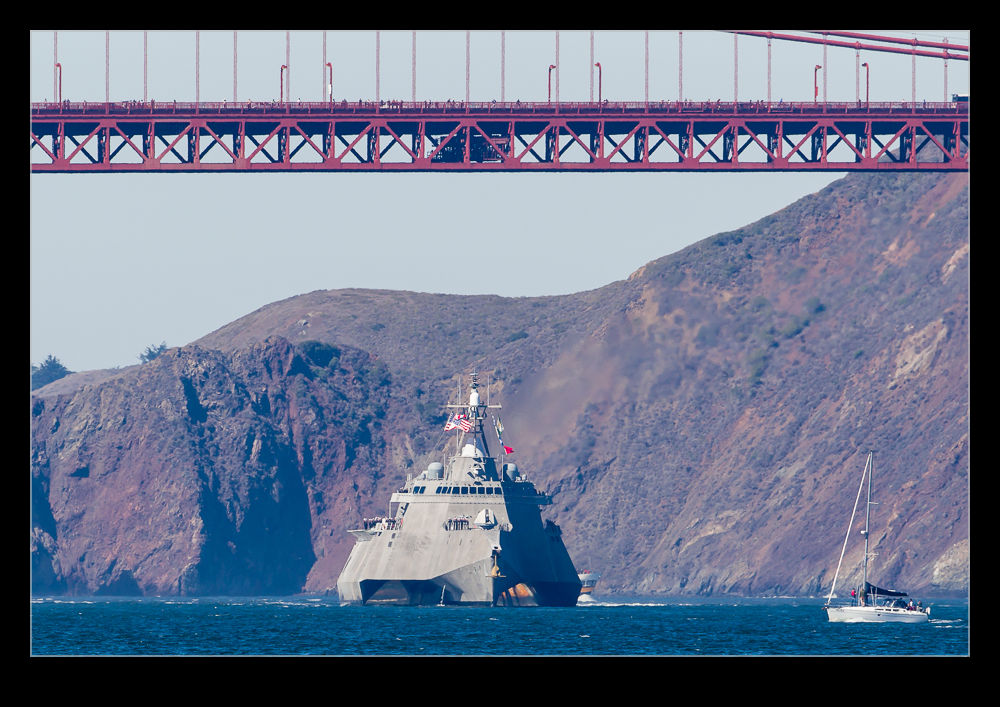 Warship design underwent quite a transition. Traditionally, warships had been slender designs that achieved speed and supposedly provided the most stable ride. However, this was not an approach that was universally agreed and shorter broader designs started to gain favor. The Royal Navy’s Type 23 frigates were one of the first signs that Navy’s were taking new configurations seriously.
Warship design underwent quite a transition. Traditionally, warships had been slender designs that achieved speed and supposedly provided the most stable ride. However, this was not an approach that was universally agreed and shorter broader designs started to gain favor. The Royal Navy’s Type 23 frigates were one of the first signs that Navy’s were taking new configurations seriously.
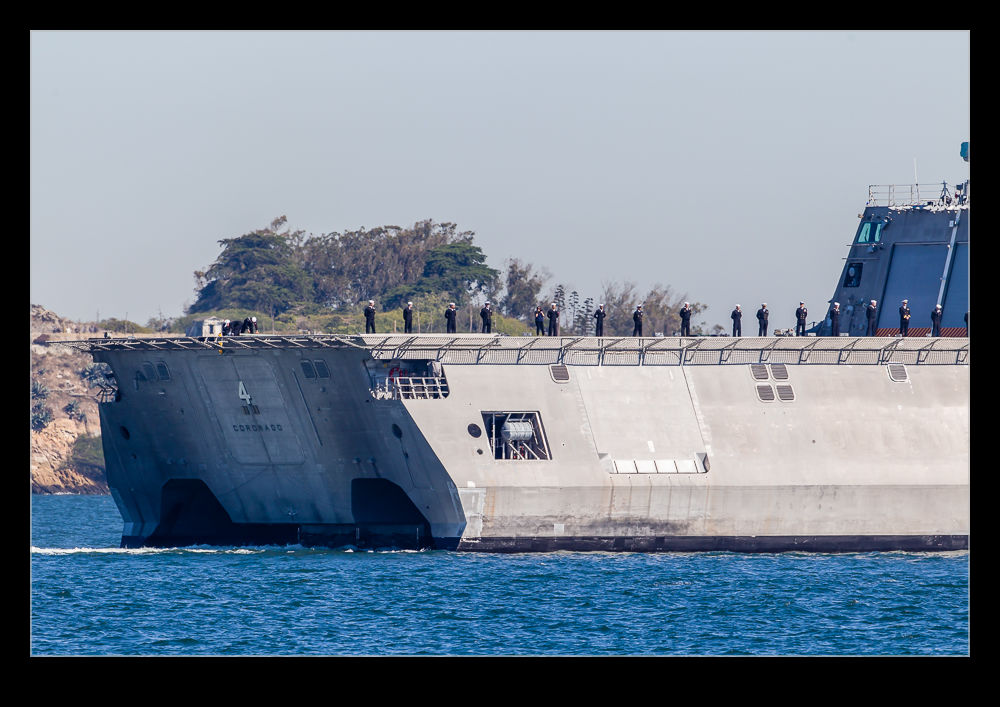 The US Navy’s Littoral Combat Ship (LCS) program has gone a stage further with one of the builders. There are two LCS designs in production and one of them has a narrow center hull and two additional outboard hulls further aft. This trimaran configuration provides slender hulls but with a lot of stability and the space for a large deck. One of the LCS ships was in San Francisco for Fleet Week and took part in the Parade of Ships.
The US Navy’s Littoral Combat Ship (LCS) program has gone a stage further with one of the builders. There are two LCS designs in production and one of them has a narrow center hull and two additional outboard hulls further aft. This trimaran configuration provides slender hulls but with a lot of stability and the space for a large deck. One of the LCS ships was in San Francisco for Fleet Week and took part in the Parade of Ships.
 USS Coronado (LCS-4) was the ship on display. She is the second of the General Dynamics – Bath Iron Works ships to be commissioned and entered service in 2014. As she entered the bay under the bridge she turned towards to city and you could get a good view (albeit at some distance) of the unusual hull shape. As she got closer, the view was more abeam the ship but you could still see the layout of the armaments. As she headed away, a view of the stern hinted at the hull layout but really emphasized the width of the deck.
USS Coronado (LCS-4) was the ship on display. She is the second of the General Dynamics – Bath Iron Works ships to be commissioned and entered service in 2014. As she entered the bay under the bridge she turned towards to city and you could get a good view (albeit at some distance) of the unusual hull shape. As she got closer, the view was more abeam the ship but you could still see the layout of the armaments. As she headed away, a view of the stern hinted at the hull layout but really emphasized the width of the deck.
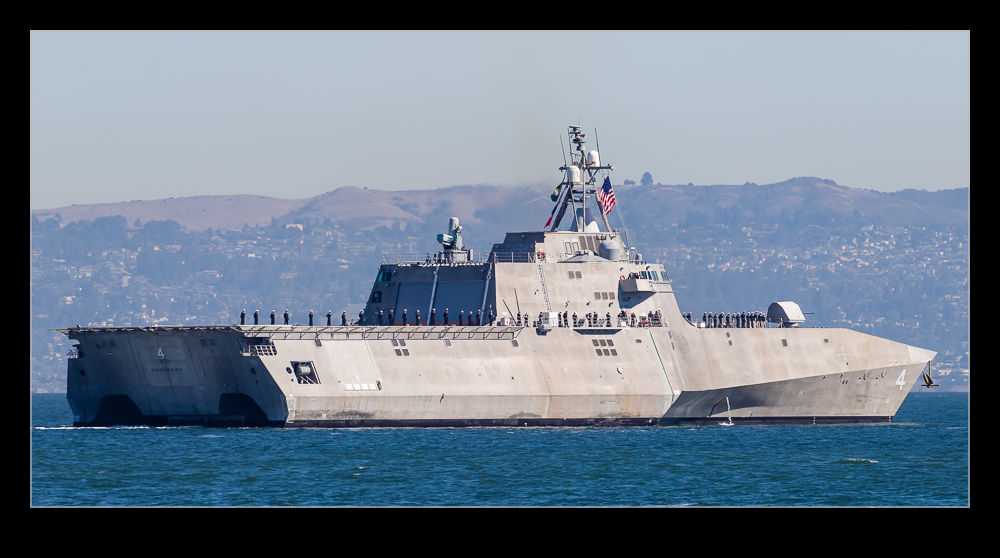 The US Navy is currently reconsidering its needs and is looking for a frigate that is more heavily armed than the LCS designs but makes as much use of the hull designs as possible. We shall see how that all works out. In the meantime, this is one of the more unusual shapes afloat. The Zumwalt destroyer is even more unusual so I shall have to try and see that at some point too.
The US Navy is currently reconsidering its needs and is looking for a frigate that is more heavily armed than the LCS designs but makes as much use of the hull designs as possible. We shall see how that all works out. In the meantime, this is one of the more unusual shapes afloat. The Zumwalt destroyer is even more unusual so I shall have to try and see that at some point too.
